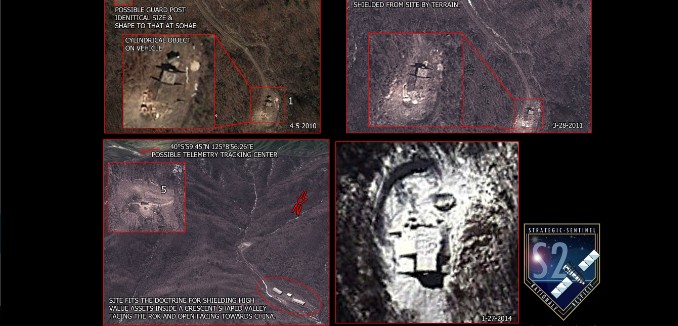The discovery of a working North Korean missile site that was previously thought to be inactive may suggest that the country is cooperating with Iran on ballistic missile and nuclear technology, Voice of America reported Wednesday.
PRESS RELEASE: Strategic Sentinel Finds Previously Unknown North Korean Site Read more here: https://t.co/NJk9a9LBgd#NorthKorea #VOA @W7VOA pic.twitter.com/f3S24izQOn
— Strategic Sentinel (@StratSentinel) December 28, 2016
Satellite images taken and analyzed by the intelligence firm Strategic Sentinel discovered a missile silo in Geumchang-ri, a mountainous area in North Pyongan province, where American intelligence believed that the country was conducting nuclear weapons research in the late 1990s.
According to Strategic Sentinel, the missile silo has dimensions very similar to one known to exist in Tabriz, Iran.
“If this Iranian site is housing missiles and the North Korean site that we have uncovered is the exact same dimension, then it’s quite possible that the site that we have uncovered is housing missiles as well,” explained Strategic Sentinel founder Ryan Barenklau. He also suggested that the two countries could be collaborating on nuclear research.
In How Iran and North Korea Became Cyber-Terror Buddies, which was published in the January 2015 issue of The Tower Magazine, investigative journalist Claudia Rosett offered some background on the two rogue nations’ history of joint missile development.
In 1992, for example, a North Korean freighter slipped past U.S. Navy surveillance and delivered a cargo of Scud missiles to the Iranian port of Bandar Abbas. In 2003, a North Korean defector testified before Congress that he traveled from North Korea to Iran in 1989 and helped the Iranians test-fire a North Korean missile. In 2007, a secret State Department cable made public by Wikileaks stated,
Iran and North Korea have continued their longstanding cooperation on ballistic missile technology via air-shipments of ballistic-missile related items. We assess that some of the shipments consist of ballistic missile jet vanes that frequently transit Beijing on regularly scheduled flights of Air Koryo and Iran Air.
In 2010, a Congressional Research Service report by analyst Larry A. Niksch estimated that “North Korea earns about $1.5 billion annually from missile sales to other countries. It appears that much of this comes from missile sales and collaboration with Iran in missile development.” Also in 2010, the New York Times reported that Iran obtained 19 missiles from North Korea that were “much more powerful than anything Washington has publicly conceded that Tehran has in its arsenal.” This too was based on a classified State Department cable made public by Wikileaks. In 2013, a report from the National Air and Space Intelligence Center stated, “Iran has an extensive missile development program, and has received support from entities in Russia, China, and North Korea.” Among Iran’s ballistic missiles is the intermediate-range Shahab 3, based on North Korea’s No Dong missile, with a range long enough to strike Israel.
This longtime partnership continues to raise the possibility that, as Rosett wrote in Forbes two weeks ago, “the two countries are also in nuclear cahoots, because ballistic missiles are basically cost-efficient only as vehicles for delivering nuclear warheads”
While Iran has scaled back its nuclear program since the signing of last year’s nuclear deal, North Korea has picked up the pace, reportedly detonating two nuclear warheads in 2016. The increase in North Korean nuclear activity as Iran was slowing down suggests that “North Korea’s nuclear program might be secretly doubling as a nuclear backshop for Iran,” she wrote.
After Pyongyang tested a nuclear weapon in early January, retired Army Maj. Gen. Robert Scales, a former commandant of the U.S. Army War College, told Fox News that “We know that the Iranians were at the last nuclear test a couple of year ago, [and] we know that the Iranians are helping the North Koreans miniaturize their nuclear weapons.” He indicated that the North Korean nuclear program experienced several failures until it received assistance from Iran. “What does this say about our nuclear deal with Iran?” Scales asked. “It says Iran is able to circumvent it by using their technological colleagues in Pakistan and their test site facility in North Korea to push their own nuclear ambitions….The Iranians and North Koreans are both developing long-range ballistic missiles by collaborating together.”
Later that month, researchers from the Foundation for Defense of Democracies published a paper (.pdf) outlining Iran’s past and present military dealings with North Korea, concluding that “the signs of military and scientific cooperation between Iran and North Korea suggest that Pyongyang could have been involved in Tehran’s nuclear and ballistic-missile program, and that state-run trading companies may have assisted in critical aspects of Iran’s illicit nuclear-related activities.” The researchers recommended a number of countermeasures, including getting China more involved in non-proliferation efforts and ensuring the transparency of the international financial system to prevent money-laundering funds used to buy or sell illicit materials.
[Photo: Strategic Sentinel / Twitter ]




